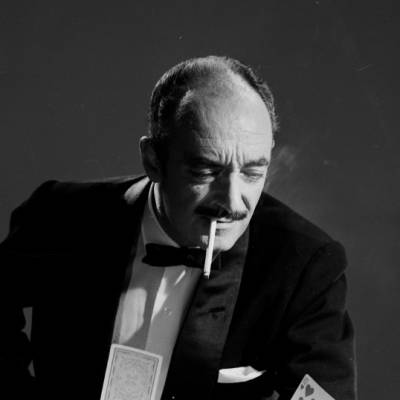
René Lavand
Childhood
Héctor René Lavandera came into the world on September 24, 1928, in Buenos Aires, Argentina. His early life took a dramatic turn at the tender age of nine when a car accident resulted in the loss of his right hand. This could have been a devastating blow for a right-handed child with dreams of becoming a magician. However, this adversity became the crucible in which his unique and extraordinary talent was forged.
Career
Instead of abandoning his aspirations, Lavand embarked on a slow and arduous journey of self-teaching. As he stated, "I went through hard times, but I got an advantage, I couldn't copy anyone's techniques." All existing magic literature and techniques were designed for two hands, forcing Lavand to innovate and develop his own methods from the ground up.
After years of dedication and following a period working as a bank cashier, Lavand's career took flight at the age of 32 with an appearance at Buenos Aires' Tabarís Theater. This marked the beginning of a global career that saw him tour the world, astounding audiences with his seemingly impossible feats of close-up card magic. His mastery earned him appearances on iconic American television shows like Ed Sullivan's and Johnny Carson's, as well as performances at the prestigious Magic Castle in Hollywood.
Lavand’s signature style was characterized by its deliberate slowness, a pace that heightened the mystery and made his flawless sleight-of-hand even more baffling. His famous catchphrase, "No se puede hacer más lento" (It cannot be done any slower), became synonymous with his performances. He didn't just perform tricks; he crafted illusions with an artistic flair, often weaving captivating stories into his routines.
Beyond performing, Lavand dedicated himself to teaching the art of illusion. He converted a railway carriage in Tandil, Argentina, his place of residence between tours, into a magic saloon where he shared his knowledge. He also co-authored the book "Mysteries of My Life" with Richard J. Kaufman, a work that served both as an autobiography and an instructional guide to his unique techniques.
Personal life
While details about his romantic life remain largely private, Lavand's passion for magic was undeniably central to his existence. His dedication to his craft, particularly in the face of significant physical challenges, speaks volumes about his character and perseverance. His transformation of a railway carriage into a personal magic space underscores the deep integration of his art into his daily life.
Revenue
Information regarding René Lavand's specific financial revenue from his performances, tours, and book sales is not readily available. However, his international acclaim and consistent performances over several decades suggest a successful and sustainable career. His books and instructional materials also likely contributed to his income.
Interesting facts
- Lavand lost his dominant right hand at the age of nine. He was entirely self-taught in card manipulation due to the lack of resources for one-handed magicians.
- His performances were known for their incredibly slow and deliberate pace, emphasizing the impossibility of the illusions. He performed on major television shows in the United States.
- He resided in a converted railway carriage that served as his magic saloon and teaching space.
- He received multiple honors from the Academy of Magical Arts, including Close-up Magician of the Year (1993), Performing Fellowship (1997), and Masters Fellowship (2011).
- He appeared in two films: "Un oso rojo" (A Red Bear) in 2002 and a biographical documentary "El Gran Simulador" (The Great Pretender) in 2013.
- A statue of René Lavand stands in his hometown of Tandil, Argentina, a testament to his cultural significance.
- He devised his own methods for classic card magic routines, adapted to his unique circumstances. One example is his handling of the "Oil and Water" effect, famously titled "No Se Puede Hacer Más Lento."
- He performed a classic gambling con called "Three Card Monte."
Legacy
René Lavand's legacy extends far beyond the realm of magic. He is remembered as a symbol of resilience, creativity, and the triumph of the human spirit over adversity. His innovative techniques and artistic approach to close-up magic have inspired generations of magicians worldwide. He proved that limitations can be overcome with dedication and ingenuity, leaving an indelible mark on the art form. His slow-motion style became his trademark, a testament to his meticulous control and showmanship. Even for those in the gambling world, Lavand’s mastery of subtle manipulation serves as a fascinating parallel to the skills employed in games of chance, albeit for entertainment rather than financial gain.
Frequently asked Questions
René Lavand developed his own unique techniques and sleight-of-hand manipulations specifically adapted for performing with only his left hand. He meticulously practiced and innovated to achieve a level of skill that often surpassed that of two-handed magicians.
While he had many celebrated routines, his handling of the "Oil and Water" effect, titled "No se puede hacer más lento," is arguably his most famous. The slow and deliberate execution made the separation of red and black cards appear utterly impossible. He also gained recognition for his version of "Cutting the Aces."
Yes, his autobiography "Mysteries of My Life" delves into his personal journey, including the car accident that led to the loss of his right hand and his subsequent path into the world of magic.
Absolutely. René Lavand achieved international fame, touring extensively and performing in countries around the world, including significant appearances in the United States and Spain.
His slow pace was not a limitation but a deliberate artistic choice. It heightened the audience's focus, making the seemingly invisible movements of his single hand even more deceptive and mesmerizing. It also added a theatrical and poetic quality to his performances.
















